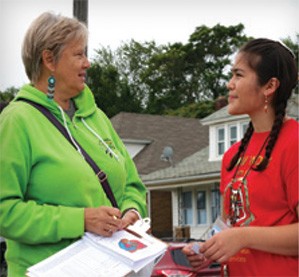
Suicide is the second-leading cause of death behind unintentional injuries among Native American children and young adults, and is on the rise, according to the Indian Health Service. The rate of suicide for American Indian/ American Native is 70 percent higher than that of the general population, and youth between age 10 and 24 are the most at risk (Dorgan, 2010). While data is sparse for urban American Indian suicides, and suicide attempts, the risk factors associated with these outcomes predict high incidence.
Manidookewigashkibjigan Sacred Bundle: R.E.S.P.E.C.T. is a collaborative program with American Indian Health and Family Services of Southeast Michigan and Assistant Professor Sandra Momper. The program utilizes both evidencebased interventions and culturally infused practice methods. Sandra is active in the American Indian community at the University of Michigan and is a board member of American Indian Health and Family Services of Detroit. The students and staff working on the program are members of the community and believe that suicide and suicidal behavior are preventable. “The first step is making the community aware of the startling youth suicide rate in the Native community. Our research will help the community recognize the signs, confront the possible causes and find solutions,” said Assistant Professor Sandra Momper.
The first step is making the community aware of the startling youth suicide rate in the Native community. Our research will help the community recognize the signs, confront the possible causes and find solutions.
The collaboration has developed a culturally competent and youth-specific screening tool for suicide risk called the Minobimaadiz Baagosendamaang: Hope & Wellness Screen. This screen includes questions from the Modified Patient Health Questionnaire (PHQ-9), demographics, questions on cultural knowledge and wrap-up questions to bring the participant to a more positive state of mind.
Screenings began with youth and young adults aged 10– 24 at community events and Powwows in the spring and summer of 2013. “I am looking forward to implementing the Minobimaadiz Baagosendamaang: Hope & Wellness Screen with my team of MSW students and community collaborators,” said Momper.